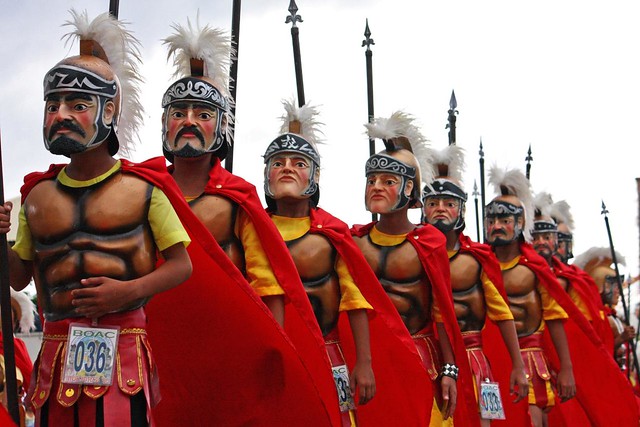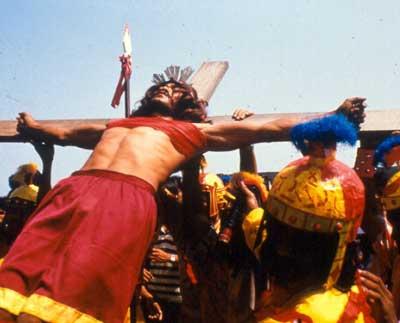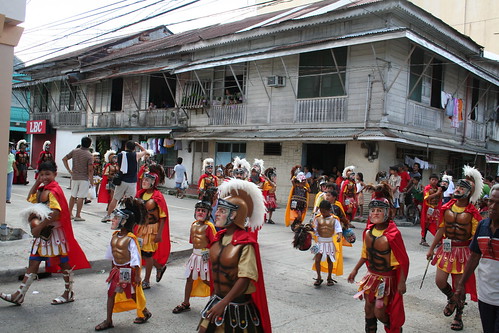
-
МјРЇСІИёСЖШИМі
-
 PASIGARBO SA SUGBO (Festival of Festivals)
PASIGARBO SA SUGBO (Festival of Festivals) 12,764
12,764 -
 Flores De Mayo in the Philippines
Flores De Mayo in the Philippines 12,283
12,283 -
 Ibalong Festival
Ibalong Festival 11,699
11,699 -
 Ati-atihan Festival11,580
Ati-atihan Festival11,580 -
 Gayon Bicol Festival11,542
Gayon Bicol Festival11,542 -
 MAGAYON FESTIVAL11,447
MAGAYON FESTIVAL11,447 -
 CARACOL FESTIVAL11,021
CARACOL FESTIVAL11,021 -
 LANZONES FESTIVAL10,660
LANZONES FESTIVAL10,660 -
 PINYASAN FESTIVAL in CAMARINES NORTE10,652
PINYASAN FESTIVAL in CAMARINES NORTE10,652 -
 Lami-lamihan Festival10,331
Lami-lamihan Festival10,331
Moriones Festival
In the Philippines, Holy Week is observed with a fervor
that mixes serious reverence leaning toward traditional
Catholic practices on one hand and folk-beliefs bordering
on the mystical, on the other hand. It is also a time for
somber, self-imposed retreats; for leisurely out-of-town drives;
planned family vacations; or cherished visits to the
individual's home province (Maundy Thursday and Good Friday
are national holidays; a four-day weekend).
The Moriones is an annual festival held on Holy Week on the island
of Marinduque, Philippines. The "Moriones" are men and women in
costumes and masks replicating the garb of biblical Roman soldiers
as interpreted by local folks. The Moriones or Moryonan tradition
has inspired the creation of other festivals in the Philippines where
cultural practices or folk history is turned into street festivals.
Colorful festivals celebrated on the island of Marinduque and
the Philippines. Morion means "mask" or "visor," a part of the
medieval Roman armor which covers the face. Moriones, on the
other hand, refers to the masked and costumed penitents who
march around the town for seven days searching for Longinus.
Morions roam the streets in town from Holy Monday to Easter
Sunday scaring the kids, or engaging in antics or surprises to
draw attention. This is a folk-religious festival that re-enacts the
story of Saint Longinus, a Roman centurion who was blind in
one eye. The festival is characterized by colorful Roman
costumes, painted masks and helmets, and brightly colored
tunics. The towns of Boac, Gasan, Santa Cruz, Buenavista
and Mogpog in the island of Marinduque become one
gigantic stage. The observances form part of the Lenten
celebrations of Marinduque. The various towns also hold
the unique tradition of the pabasaor the recitation of
Christ's passion in verse.Then at three o'clock on Good
Friday afternoon, the Santo Sepulcro is observed,
whereby old women exchange verses based on the Bible
as theystand in wake of the dead Christ. One of the
highlights of this festival is the Via Crucis. A re-enactment
of the suffering of Christ on his way to the calvary.
Men inflict suffering upon themselves by whipping their
backs, carrying a wooden cross and sometimes even
crucifixion. They see this act as their form of atonement
for their sins. This weeklong celebration starts on
Holy Monday and ends on Easter Sunday.
Background
The term "Moriones" was concocted by the media in the 60s, but local
inhabitants have kept the original term, "Moryonan". Many practitioners
are farmers and fishermen who engage in this age-old tradition as a
vow of penance or thanksgiving. Legend has it that Longinus pierced
the side of the crucified Christ. The blood that spurted forth touched
his blind eye and fully restored his sight. This miracle converted Longinus
to Christianity and earned the ire of his fellow centurions. The
re-enactment reaches its climax when Longinus is caught and beheaded.
History
In Valencia, Spain there is a similar celebration called Festival
de Moros y Cristianos (Moors and Christians Festival). It is almost
certain that the word "Moriones" was derived from "Moros".
Another possible derivation is from the Spanish word "murió"
(root:morir) meaning death. The origin of the festival is traced
to Mogpog and the year 1807 when the parish priest of said town,
Fr. Dionisio Santiago, organized it for the first time.

- ЁЄ
- ЁЄ
- ЁЄSalapan Festival
- ЁЄEmpanada Festival (Batac City)
- ЁЄPADUL-ONG FESTIVAL
- ЁЄKaumahan Festival in Barili
- ЁЄKAGASANGAN FESTIVAL
- ЁЄLalin Festival in Asturias
- ЁЄTinabuay Festival
- ЁЄGayon Bicol Festival
- ЁЄPINYASAN FESTIVAL in CAMARINES
- ЁЄMAGAYON FESTIVAL
- ЁЄBANAUAN FESTIVAL (BARANGAY.GUA
- ЁЄThe Tuna Festival in Gensan
- ЁЄPINTOS FESTIVAL BOGO CITY, CEB



- ЁЄ
- ЁЄ
- ЁЄ
- ЁЄCEBU WESTOWN LAGOON
- ЁЄGREEN LAGOON, COMPOSTELA
- ЁЄCALLAO CAVE
- ЁЄMOUNT PINATUBO IN PHILIPPINES
- ЁЄBATAN ISLAND in Batanes.
- ЁЄCALAGUAS ISLAND, CAMARINES NOR
- ЁЄAGHO ISLAND
- ЁЄCARAMOAN ISLAND IN CAMARINES S
- ЁЄSAMBAWAN ISLAND
- ЁЄPLACES TO VISIT IN LANAO DEL N
- ЁЄPLACES TO VISIT IN ZAMBOANGA C
- ЁЄPlaces to visit in Rizal Provi













 ЧЪРкДхФФ ОпАЃЛѓДу ПРЧТ
ЧЪРкДхФФ ОпАЃЛѓДу ПРЧТ 12ГтПЌМг МвКёРкИИСЗ 1РЇ
12ГтПЌМг МвКёРкИИСЗ 1РЇ
 ГЛАд ИТДТ ОюЧаПј УЃБт
ГЛАд ИТДТ ОюЧаПј УЃБт
 ИЎОѓ ЧаБГ ЙцЙЎБт
ИЎОѓ ЧаБГ ЙцЙЎБт
 СжИЛПЁ ГЛАЁ ОЕ КёПыРК?
СжИЛПЁ ГЛАЁ ОЕ КёПыРК? УжАэАЁМККё РЬКЅЦЎ СёБтБт
УжАэАЁМККё РЬКЅЦЎ СёБтБт
 ЧіСіПЁМЕЕ ЧЪРкДхФФ!
ЧіСіПЁМЕЕ ЧЪРкДхФФ! ЧіСіПЁМ АЁДЩЧб
ЧіСіПЁМ АЁДЩЧб









 ЧЪРк ЦЏБо Ч§ХУ! ФСНУОюСі МКёНК
ЧЪРк ЦЏБо Ч§ХУ! ФСНУОюСі МКёНК











































